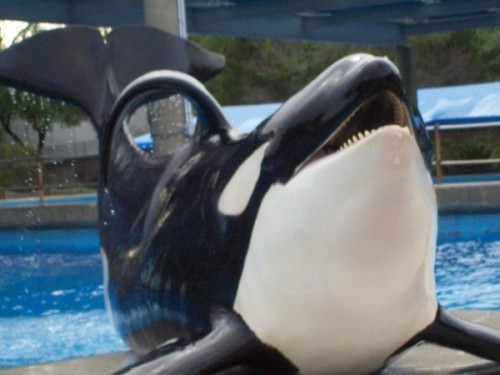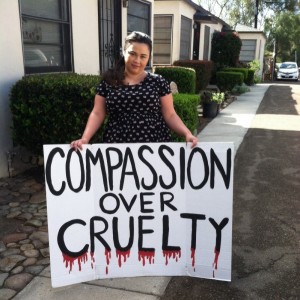This is the fifth in a series of ten in which we meet one of the San Diego 10 orcas and hear from an advocate who continues to be one of the voices of these imprisoned voiceless, never stopping until the whole world listens.
This week’s Prisoner Advocate is Doni Lantow.
Prisoner #5: Keet
Age: 21
Born on February 2, 1993, at Sea World San Antonio, Keet (his name is Tlingit Indian for “orca”) is known for being the grandbaby of Shamu, and also for being one of the most heavily transported orcas in captive history. It’s amazing this beautiful orca has such a gentle nature considering how disruptive his entire life has been.

Barely 18 months old when he was separated from his mother, Kalina, Keet was left behind when she was moved away from him to Sea World Orlando, pregnant with another calf. Remember, in the wild, orcas generally live in close-knit family pods consisting of several females, calves, one or more males and/or juveniles. There are some pods that consist of a mother and her offspring who stay with her for life. Many pods have been documented as stable, consistent matriarchal family groups with several generations traveling together. So being separated from his mother was inherently unnatural for an orca—even for those born captive and separated from their familial pods.
At five years old, he was then moved from San Antonio to San Diego where he spent five months before that being flown to (the now defunct) Sea World Ohio. After just one season there, he was again returned to San Diego.
During his second stay in San Diego, Keet sired his first calf, Kalia, born to Kasatka (Prisoner #2 in this Series) on December 21, 2004. Father and daughter met when he returned to San Diego for the third time on February 27, 2012. During his return to San Antonio, in 2004, Keet sired his second calf with Kayla (the first orca born in Sea World San Antonio). Her baby was born on October 9, 2005 (she might have been premature) and was named Halyn. And this is another example of the tragic results of separating pod families.
Because Kayla never was able to learn from having her mother by her side throughout her life, she never knew how to be a mother herself. It is no surprise that she rejected her baby daughter, Halyn, and the baby had to be raised by trainers. Eventually, Kayla was moved to Sea World Orlando in November 2006 to learn how to take care of calves from other experienced moms living there.
As little Halyn grew, she was moved back to Shamu Stadium where she was introduced to her father, Keet, whose gentle and sweet nature proved to be a comforting patriarchal tank mate for the little orca. Usually fathers don’t play a role in raising calves, but Keet did very well with his daughter, teaching her ever so patiently how to be an orca. Though he wasn’t what you’d call a playful pop, he tolerated his little daughter’s youthful antics and proved to be a wonderful companion and teacher for her. It wasn’t long before the two were forced to perform together in the Sea World shows. Sadly, in June 15, 2008, Halyn became ill from Encephalitis and died.
In February 27, 2012, Keet returned yet again to Sea World San Diego, where he’s grouped with the orcas there and, being as submissive as he is, seems to get along with orcas and trainers equally without showing signs of aggression. In San Antonio, the other orcas were quite aggressive towards him. Keet and Orkid (Prisoner #4 in this series) have mated several times since his arrival, though given her history, she is likely not to get pregnant. Keet also attempted mating Shouka (Prisoner #6 in this series) since her transfer there as well.
Like Orkid, Keet’s family tree tells the tragic story of orca captivity. Keet is 75% percent Icelandic by his wild-caught father, Kotar, and his mother, Kalina, the first survivor of captive breeding, through her mother, Katina; and 25% Northern Resident/Washington State through his maternal grandfather, Winston.
You may recall from Orca Profile #2 of Kasatka that Kotar also fathered her first child, Takara. Like Katina and Kasatka, Kotar was captured in Icelandic waters in 1978, and he was very young, probably less than one year old. He spent his first couple years of captivity at SeaWorld San Diego, moved to SeaWorld Orlando where he bit another male orca’s penis (Kanduke) and was then moved to SeaWorld San Antonio (1988). On April 1, 1995, Kotar died from a fractured skull and severe blood loss caused by a gate closing on his head.
Keet’s maternal grandfather, Winston, was captured in the infamous Penn Cove hunt recounted in the documentary, “Blackfish”, on August 8, 1970, after his pod of eighty orcas was “corralled” near Coupeville, Washington; six others were also caught, while four died, their bellies slit, filled with rocks and sunk to hide their deaths – they later washed up onshore.
Their discovery helped fuel the banning of SeaWorld from the waters off Washington State, and the Southern Resident Killer Whales of which his natal “L-pod” was declared Endangered by the United States, as a result of their hunting and capture for entertainment in the 60′s and 70′s. Winston spent six years at the now-defunct Windsor Safari in England as “Ramu”, then was sold to SeaWorld and transported to San Diego, where he died on April 28, 1986, of chronic cardiovascular failure, at less than 20 years old.
Keet’s mother, Kalina, was the first survivor of SeaWorld’s captive breeding program after several stillbirths and calves who didn’t survive weaning. She was bred to Kotar, her mother’s Icelandic capture peer. Sadly, on October 4, 2010, Kalina died at SeaWorld Orlando of Bacterial Septicemia, a systemic inflammatory response to a severe infection or more simply, blood poisoning. She didn’t die of a Gall Bladder Infection, Appendicitis, or burns. Did she have some (minor) surgical procedure or other wounds SeaWorld didn’t share with the world? Infections of the mouth or teeth, when untreated by antibiotics, cause septicemia, and like many captive orcas, Kalina had a well-documented history of many fractured teeth as well as those that were manually drilled. She was most assuredly treated with antibiotics so often over her 25 years in captivity that they were ineffective, just as they are for humans after prolonged usage.
Our wish is that the next move this beautiful orca will make is to a sea pen sanctuary where Keet may live in peace only showing up to be happy—not having to perform – to live the harmonious life he so deserves.
Prisoner Advocate: Doni Lantow
Doni Lantow has lived in San Diego since 2009. But, being child in a military family, she’s lived in over a handful of cities throughout the United States.

At present, Doni lives in Hillcrest with her fiancé, a golden retriever and three cats. As a senior account representative in a large account receivable firm she’s got a lot on her plate during the day. And that might have been enough until something happened to change her life.
“I watched an airing of Blackfish and decided to attend a local protest at SeaWorld San Diego. It was at this demonstration that I became inspired to create the Facebook page titled Protest SeaWorld – the San Diego Community page. The goal of this page is to create a centralized source where one could meet others, share news articles and promote upcoming demonstrations.
“My passion for SeaWorld’s captive cetaceans comes from my ability to empathize with them. SeaWorld’s cetaceans, orcas in particular, are subjected to what I believe are the worst exploitation. In the wild, orcas travel dozens even upward to a hundred miles a day.
While it’s easy to point out that the San Diego10 are populated with a majority of captive-born orcas it’s important to remember that their parents and their grandparents were wild. Evolution has not occurred in the last 40-something years. In spite of their years of endless captivity, their inherent ability and desire to swim freely hasn’t disappeared in the last few decades.
“Their social structures are also very similar to our own. Their pods are filled with lifelong companions, sometimes never leaving each other’s side unless death occurs. Yet, we’ve seen Sea World abuse families of orcas by separating mothers from their calves at premature ages and even artificially interbreeding family members with one another.
Even more dangerous, Sea World also houses transient and resident orcas together. For fear of aggression, the two sub-species intentionally avoid one another in the wild. Studies have shown that the two subspecies haven’t crossbred – EVER. Yet, Sea World disregards science and encloses and breeds them together. It’s both dangerous and unethical.
“These animals are also extremely intelligent. I believe the immensity and complexity of their intelligence isn’t even fully understood today. Orcas are also friendly, docile and compliant. These are traits that should be appreciated not exploited. To teach these animals to perform tricks for food degrades the intelligence of both the animals “performing” and the audiences watching.
“I want to see the San Diego10 retired. I wish to see them “released” from their artificial, chlorinated prisons to spacious enclosures in the ocean where they can feel the natural current of their sea and no longer be surrounded by metal, glass, loud speakers, music and fireworks.
“I wish Sea World would end their breeding program entirely. There is no need to continue to intentionally breeding more animals that are not “suitable for release.”
“I wish for Sea World to become the “police-protectors” of marine-mammal parks across the world. Condemn the drive-hunts in Taiji, Japan and demand adequate housing for orcas like Lolita at the Miami Seaquarium.
“Sea World needs to change its business model. They need to focus on creating a sanctuary for these orcas. They need to focus on building more family-friendly rides and restaurants. They need to create shows without the use of live animals. If they did this they would make even more than the multi-billion dollar industry they have today based on a foundation of abusement not amusement.
“I hope that Sea World adheres to all of these suggestions, but at the very least I hope they STOP BREEDING. Yes, while we understand that these animals may not survive if released to the wild, it’s still unimaginable to most of us why they would continue to force breed these orcas more and more. It’s got to stop.”
Find us on:
Facebook: www.facebook.com/protestseaworldsandiego
Twitter: Protestsw
Instagram: Protestseaworld
“There is only one perpetrator of evil on the planet: human unconsciousness.”
– Echart Tolle, A New Earth
